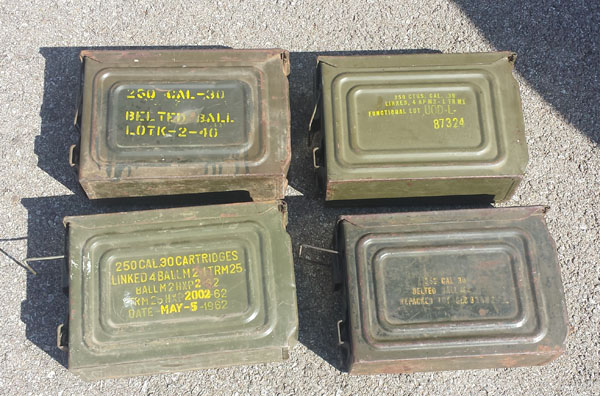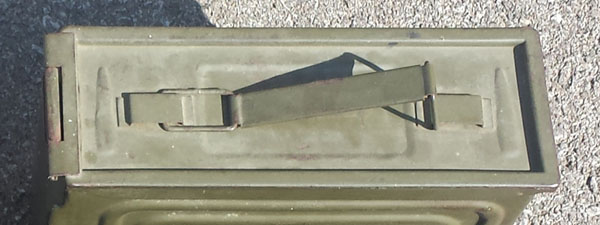De-Farbing the Browning 30 Caliber: The M1A1 Ammo Can
Date Written: May 25, 2015
Author: Chris Guska
Background:
In 2009 I started on my 1917A1 Watercooled Browning 30 project, building a Rock Island steel trunion example up from loose part and gathering the accessories to go with it. The wooden Chest 49-1-84 was detailed while I was in the heat of my 1917A1 frenzy, but its metal counter part, the M1A1 ammo can has waited 6 years to get words and photos together. I was graciously gifted a M1A1 ammo can at the time, and had picked up several more over the years in buying the CMP surplus HXP and Knyoch ammunition on 250 round belts.Voraciously reading materials available at the time, there was a mention on the 1919A4 forum of the M1A1 ammo cans being essentially a post war item. This ran contrary to popular sentiment amongst reenactors who utilized the M1A1 ammo can prominently on anything it would mount to.
Dolf Goldsmith dedicated two pages to the M1A1 ammo can, and its trial predecessor the M1E1 ammo can in his third volume of his series "The Browning Machine Gun", laying out the shortcomings and process that led to the adoption of the M1A1 ammo can.
If you've ever used a M1 ammo can before, these things that Dolf Goldsmith documents as combat complaints that lead the army to seek a new ammo can:
- A cloth belt of 250 rounds is a very tight fit - with force needed to close the lid on a full can.
- The closure is easily bent
- The lid hinge is weak
- The lid can be put on askew, damaging the can and the lid
- The gasket in the lid is a joke
- The M1 ammo can doesn't stay mounted on a cradle in vehicle use
The Item:
The M1A1 ammo can is distinguished from the M1 ammo can by a different closure latch as well as a mounting latch for 1917A1 cradles and vehicle mounts. The latch on the M1A1 can is a short tab, while on the M1 can it is a longer lever, going down to where the tripod latch is on the M1A1.
The overall shape of the can is slightly different, with the lid having a different stamping pattern and handle detail, lacking the raised reinforcement around the handle of the M1 can. Additionally, the hinge design was totally re-done to prevent the lid being closed at an angle, preventing damage of both the can and the gasket.
M1A1 ammo cans may be marked M1 or M1A1 depending on the contractor who made them.
Additionally the bottoms of the M1A1 cans are flat, while the M1's have a stamped pattern. This effectively increases the internal volume of the container without increasing the external dimensions significantly. A full belt of ammunition could now be packed in the can and closed without undue force.
The Contracts:
While researching M8 Grenade Launcher contracts, I stumbled upon contract listings for a number of items of relation to the Browning 30 cal, specifically the “Box, Amm. Cal 30., M1A1”.There are 4 manufacturers listed, with the initial Purchase Order dated 3/29/1945 for United Metal Box Co of Brooklyn, N.Y. for 4 million units for delivery through December 1945. Three additional contractors were added during the month of April, for procurement of 3.4 million more M1A1 ammo cans.
There are no contracts awarded prior to 3/29/45 for this item.
A brief chronology-
3/29/45 – United Metal Box Co, 4M, March 45 to December 45
4/6/45 – Falls Spring & Kiro Company, 1.5M, April 45 to December 45
4/14/45 – Mullins Mfg Co, 1M, 1M, May 45 to December 45
4/18/45 – Artcraft Metal Products, 900K, March 45 to December 45
The contracts specify delivery beginning in March 1945, for United Metal Box and Artcraft, there are two ways to interpret the contract data, such that it appears that production started before purchase orders were finalized - OR – that the purchase orders took time to iron out the details and the specified delivery dates were not updated to reflect the date of record for the PO. For my analysis and conclusion, I believe that the production was started on speculation prior to the PO being approved.
Dolf Goldsmith notes that the M1E1 was standardized by the Army as the "Box, Ammunition, Caliber 30, M1A1" on July 20, 1945, months after the initial contracts were let. While the date of standardization is helpful to note, it is more of a bureaucratic move than an official start date of production or issue.
Conclusion:
The “Box, Amm. Cal 30., M1A1” is questionable if it saw any service up front with combat troops.. With Production starting in March, the assumption would be that it would be late April to early May before the items could possibly reach the ETO. It is plausible that these ammo cans were packed, shipped and may have ended up in the PTO prior to the cessation of hostilities – and then would be greatly outnumbered by their M1 ammo can brothers. If you are doing a Normandy impression or any presentation prior to March of 45, these just didn't exist yet so leave them at home or in your car.
Sources:"Further Complaints with the M1 Box Lead to the M1E1 Box." The Browning Machine Gun - Supporting the Rifle Caliber Brownings. 3rd ed. Vol. 3. Canada: Collector Grade Publications, 2008. 211-12. Print.
United States. Army Service Forces. Ordnance Department. Digest of Significant Purchase Actions. Print
90th IDPG Articles






